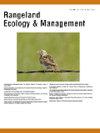没有改变就没有希望:透视我们如何保护沙棘生物群落
IF 2.4
3区 环境科学与生态学
Q2 ECOLOGY
引用次数: 0
摘要
这不是一篇典型的期刊论文,无论是语气还是风格都与众不同。作为以 "鼠尾草保护设计和战略保护 "为主题的特刊的一部分,本文重点介绍了我们需要如何改变对鼠尾草生物群落的管理,并从一个角度阐述了这种改变为何如此重要。由于入侵性一年生草类、针叶林扩张、灾难性野火和气候变化等改变生物群落的威胁,沙棘生态系统正在急剧衰退,几十年来每年损失的面积超过 100 万英亩。正如本特刊中的其他论文所指出的,鼠尾草生物群落的管理需要发生巨大的变化,将预防和恢复的重点放在完整的地貌上,同时承认我们无法让已经消失的生物群落重现生机。在我们选择改变生物群落管理方式的同时,也要考虑改变的原因。在本文中,我列举了一系列个人轶事、观察和联系,希望能帮助读者理解本特刊的内容,这不仅是一套完整的科学体系,也是我们与生物群落未来的关系。我通过在萨格布鲁什保护设计核心区和增长区周围应用 "保护和增长核心区 "框架,并结合 "抵制、接受、引导 "模式的原则来拥抱未来。生态系统管理方面最大的差距不是因为缺乏知识,而是因为缺乏明确的管理重点和资金,以及恢复和管理我们最后希望地域的强大社会能力。通过以悲观主义者和乐观主义者的双重视角来看待该地区的困境,我希望您能深刻感受到我们所面临的机遇和紧迫性,在我们做什么以及在哪里做的问题上做出艰难的选择,建立起对恢复经济的长期承诺,并支持人们拯救鼠尾草海。本文章由计算机程序翻译,如有差异,请以英文原文为准。
There Is No Hope Without Change: A Perspective on How We Conserve the Sagebrush Biome
This is not a typical journal article in tone or style. As part of a special issue focused on the Sagebrush Conservation Design and Strategic Conservation, this paper highlights how we need to change our management of the sagebrush biome with a perspective of why that change matters. Sagebrush ecosystems are in steep decline, losing more than 1 million acres annually for decades from biome-altering threats of invasive annual grasses, conifer expansion, catastrophic wildfire, and climate change. As illustrated by the other papers in this special issue, management of the sagebrush biome needs to drastically change, focusing prevention and restoration on intact landscapes while accepting we cannot bring back the biome where it is already lost. Imbedded in this choice to change how we manage the biome is why that change matters. In this paper I include a series of personal anecdotes, observations, and connections that I hope helps you, the reader, understand the content of this special issue not only as an integrated body of science, but also an embrace of how we relate to the future of the biome. I embrace that future by applying the Defend and Grow the Core framework around Sagebrush Conservation Design Core and Growth Areas, and by layering in the tenants of the Resist, Accept, Direct model. The biggest gaps for ecosystem management are not from lack of knowledge, but from lack of clear administration priorities and funding, and robust social capacity to restore and steward our last geographies of hope. By using both a pessimist's and optimist's perspective on the plight of the range, I hope you deeply sense the opportunity and the urgency we face, making hard choices of what we do and where, building a long-term commitment to a restoration economy, and supporting people to save the sagebrush sea.
求助全文
通过发布文献求助,成功后即可免费获取论文全文。
去求助
来源期刊

Rangeland Ecology & Management
农林科学-环境科学
CiteScore
4.60
自引率
13.00%
发文量
87
审稿时长
12-24 weeks
期刊介绍:
Rangeland Ecology & Management publishes all topics-including ecology, management, socioeconomic and policy-pertaining to global rangelands. The journal''s mission is to inform academics, ecosystem managers and policy makers of science-based information to promote sound rangeland stewardship. Author submissions are published in five manuscript categories: original research papers, high-profile forum topics, concept syntheses, as well as research and technical notes.
Rangelands represent approximately 50% of the Earth''s land area and provision multiple ecosystem services for large human populations. This expansive and diverse land area functions as coupled human-ecological systems. Knowledge of both social and biophysical system components and their interactions represent the foundation for informed rangeland stewardship. Rangeland Ecology & Management uniquely integrates information from multiple system components to address current and pending challenges confronting global rangelands.
 求助内容:
求助内容: 应助结果提醒方式:
应助结果提醒方式:


